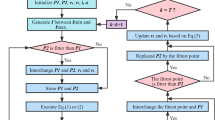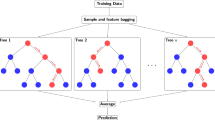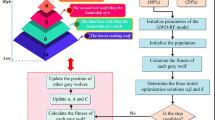Abstract
Gas breakthrough pressure is a significant parameter for the gas exploration and safety evaluation of engineering barrier systems in the carbon dioxide storage, remediation of contaminated sites, and deep geological repository for disposal of high-level nuclear waste, etc. Test for determining gas breakthrough pressure is very difficult and time-consuming, due to the low/ultra-low conductivity of the specimen. It is also difficult to get a comprehensive and high-precision model based on limited results obtained through individual experiments, as the measurements of gas breakthrough pressure were influenced by many factors. In this study, a collected database was built that covered a lot of former test data, and then, two models were developed by the random forest (RF) algorithm and multiexpression programming (MEP) method. The MEP model constructed with explicit expressions for the gas breakthrough pressure overcame the drawbacks of common “black box” models. Meanwhile, five significant indicators were selected from ten common features using the permutation importance algorithm. The RF model was interpreted by the Shapley value and the PDP/ICE plots, while the MEP model was analyzed through the proposed explicit expression, showing strong consistence with that in former studies. Finally, robustness analysis was conducted, and stability of the proposed two models was verified.



















Similar content being viewed by others
Data availability
All data will be made available on reasonable request.
References
Afnan MAM, Ali F, Worthington H, Netke T, Singh P, Kajamuhan C (2021) Triage nurse prediction as a covariate in a machine learning prediction algorithm for hospital admission from the emergency department. Int J Med Inform 153:104528. https://doi.org/10.1016/j.ijmedinf.2021.104528
Ahmadi MA (2015) Connectionist approach estimates gas-oil relative permeability in petroleum reservoirs: application to reservoir simulation. Fuel 140:429–439. https://doi.org/10.1016/j.fuel.2014.09.058
Alavi AH, Gandomi AH, Sahab MG, Gandomi M (2010) Multi expression programming: a new approach to formulation of soil classification. Engineering with Computers 26(2):111–118. https://doi.org/10.1007/s00366-009-0140-7
Amann-Hildenbrand A, Bertier P, Busch A, Krooss BM (2013) Experimental investigation of the sealing capacity of generic clay-rich caprocks. Int J Greenh Gas Control 19:620–641. https://doi.org/10.1016/j.ijggc.2013.01.040
Ao YL, Li HQ, Zhu LP, Ali S, Yang ZG (2019) The linear random forest algorithm and its advantages in machine learning assisted logging regression modeling. Pet Sci Eng 174:776–789. https://doi.org/10.1016/j.petrol.2018.11.067
Bai JR, Song KT, Chen JB (2018) The migration of heavy metal elements during pyrolysis of oil shale in Mongolia. Fuel 225:381–387. https://doi.org/10.1016/j.fuel.2018.03.168
Belmahdi B, Louzazni M, El Bouardi A (2022) Comparative optimization of global solar radiation forecasting using machine learning and time series models. Environ Sci Pollut R 29(10):14871–14888. https://doi.org/10.1007/s11356-021-16760-8
Breiman L (2001) Random forests. Machine Learn 45(1):5–32. https://doi.org/10.1023/A:1010933404324
Busch A, Hildenbrand AA (2013) Predicting capillarity of mudrocks. Mar Pet Geol 45:208–223. https://doi.org/10.1016/j.marpetgeo.2013.05.005
Carvalho DV, Pereira EM, Cardoso JS (2019) Machine learning interpretability: a survey on methods and metrics. Electronics 8(8):832. https://doi.org/10.3390/electronics8080832
Chang YS, Abimannan S, Chiao HT, Lin CY, Huang YP (2020) An ensemble learning based hybrid model and framework for air pollution forecasting. Environ Sci Pollut R 27(30):38155–38168. https://doi.org/10.1007/s11356-020-09855-1
Chen YG, Ye WM, Xie ZJ, Chen B, Cui YJ (2012) Remediation of saturated Shanghai sandy silt contaminated with p-xylene using air sparging. Nat Hazards 62:1005–1020. https://doi.org/10.1007/s11069-012-0129-1
Cui LY, Ye WM, Wang Q, Chen YG, Chen B, Cui YJ (2019) Investigation on gas migration in saturated bentonite using the residual capillary pressure technique with consideration of temperature. Process Saf Environ Protect 125:269–278. https://doi.org/10.1016/j.psep.2019.03.036
Cui LY, Ye WM, Wang Q, Chen YG, Chen B, Cui YJ (2020) Insights into determination of gas breakthrough in saturated compacted Gaomiaozi bentonite. J Mater Civ Eng 32(7):04020190. https://doi.org/10.1061/(ASCE)MT.1943-5533.0003206
Cui LY, Ye WM, Wang Q, Chen YG, Chen B, Cui YJ (2021a) Influence of cyclic thermal processes on gas migration in saturated GMZ01 bentonite. J Nat Gas Sci Eng 88:103872. https://doi.org/10.1016/j.jngse.2021.103872
Cui LY, Ye WM, Wang Q, Chen YG, Chen B, Cui YJ (2021b) Insights into gas migration behavior in saturated GMZ bentonite under flexible constraint conditions. Constr Build Mater 287:123070. https://doi.org/10.1016/j.conbuildmat.2021.123070
Cui LY, Masum SA, Ye WM, Thomas HR (2021c) Investigation on gas migration behaviours in saturated compacted bentonite under rigid boundary conditions. Acta Geotech 1–15. https://doi.org/10.1007/s11440-021-01424-1
Davy CA, Skoczylas F, Lebon P, Dubois T (2009) Gas migration properties through a bentonite/argillite interface. Appl Clay Sci 42:639–648. https://doi.org/10.1016/j.clay.2008.05.005
de Melo VV, Banzhaf W (2018) Automatic feature engineering for regression models with machine learning: an evolutionary computation and statistics hybrid. Inf Sci 430:287–313. https://doi.org/10.1016/j.ins.2017.11.041
Derjaguin BV, Karasev VV, Khromova EN (1992) Thermal expansion of water in fine pores. Prog Surf Sci 40(1–4):391–392. https://doi.org/10.1016/0079-6816(92)90067-R
Gallé C (2000) Gas breakthrough pressure in compacted Fo–Ca clay and interfacial gas overpressure in waste disposal context. Appl Clay Sci 17(1):85–97. https://doi.org/10.1016/S0169-1317(00)00007-7
Gallé C, Tanai K (1998) Evaluation of gas transport properties of backfill materials for waste disposal: H-2 migration experiments in compacted Fo-Ca clay. Clay Clay Min 46:498–508. https://doi.org/10.1346/CCMN.1998.0460503
Ghorbel H, Zannini N, Cherif S, Sauser F, Grunenwald D, Droz W, Baradji M, Lakehal D (2019) Smart adaptive run parameterization (SArP): enhancement of user manual selection of running parameters in fluid dynamic simulations using bio-inspired and machine-learning techniques. Soft Comput 23(22):12031–12047. https://doi.org/10.1007/s00500-019-03761-6
Graham J, Halayko KG, Hume H, Kirkham T, Gray M, Oscarson D (2002) A capillarity-advective model for gas break-through in clays. Eng Geol 64(2–3):273–286. https://doi.org/10.1016/S0013-7952(01)00106-5
Gupta D, Natarajan N, Berlin M (2022) Short-term wind speed prediction using hybrid machine learning techniques. Environ Sci Pollut R 29(34):50909–50927. https://doi.org/10.1007/s11356-021-15221-6
Gutiérrez-Rodrigo V, Villar MV, Martin PL, Romero FJ, Barcala JM (2015) Gas-breakthrough pressure of FEBEX bentonite. Gas Gen Migr Deep Geol Radioactive Waste Repos 415:47–57. https://doi.org/10.1144/SP415.4
Halayko KSG (1998) Gas flow in compacted clays. MSc thesis, University of Manitoba, Winnipeg MB, pp 128. http://hdl.handle.net/1993/1306
Harrington JF, Horseman ST (1999) Gas transport properties of clays and mudrocks. Geol Soc London Spec Publ 158(1):107–124. https://doi.org/10.1144/GSL.SP.1999.158.01.09
Harrington JF, Horseman ST (2003) Gas migration in KBS-3 buffer bentonite. Technical Report TR-03–02. British Geological Survey
Harrington JF, de la Vaissiere R, Noy DJ, Cuss RJ, Talandier J (2012) Gas flow in Callovo-Oxfordian claystone (COx): results from laboratory and field-scale measurements. Mineral Mag 76(8):3303–3318. https://doi.org/10.1180/minmag.2012.076.8.43
Harun MA, Safari MJS, Gul E, Ab Ghani A (2021) Regression models for sediment transport in tropical rivers. Environ Sci Pollut R 28(38):53097–53115. https://doi.org/10.1007/s11356-021-14479-0
Hildenbrand A, Ghanizadeh A, Krooss BM (2012) Transport properties of unconventional gas systems. Mar Pet Geol 31(1):90–99. https://doi.org/10.1016/j.marpetgeo.2011.11.009
Hildenbrand A, Krooss BM, Busch A, Bertier P (2015) Laboratory testing procedure for CO2 capillary entry pressures on caprocks. Carbon dioxide capture for storage in deep geological formations. CPL Press and BPCNAI. Gerdes, K. F. pp. 355–384. https://www.researchgate.net/publication/292979110_Laboratory_Testing_Procedure_for_CO2_Capillary_Entry_Pressures_on_Caprocks
Hildenbrand A, Schlomer S, Krooss BM (2002) Gas breakthrough experiments on fine-grained sedimentary rocks. Geofluids 2(1):3–23. https://doi.org/10.1046/j.1468-8123.2002.00031.x
Hildenbrand A, Schlomer S, Krooss BM, Littke R (2004) Gas breakthrough experiments on pelitic rocks: comparative study with N-2, CO2 and CH4. Geofluids 4(1):61–80. https://doi.org/10.1111/j.1468-8123.2004.00073.x
Horseman ST, Harrington JF, Sellin P (1999) Gas migration in clay barriers. Eng Geol 54(1–2):139–149. https://doi.org/10.1016/S0013-7952(99)00069-1
Hume HB (1999) Gas break-through in compacted Avonlea bentonite. MSc thesis, University of Manitoba, Winnipeg MB, pp 169
Ito D, Akaku K, Okabe T, Takahashi T, Tsuji T (2011) Measurement of threshold capillary pressure for seal rocks using the step-by-step approach and the residual pressure approach. 10th International Conference on Greenhouse Gas Control Technologies, Amsterdam, NETHERLANDS. 5211–18. https://doi.org/10.1016/j.egypro.2011.02.499
Javaheri M, Nattwongasem D, Jessen K (2013) Relative permeability and non-wetting phase plume migration in vertical counter-current flow settings. Int J Greenhouse Gas Control 12:168–180. https://doi.org/10.1016/j.ijggc.2012.10.006
Jin YF, Yin ZY (2020) An intelligent multi-objective EPR technique with multi-step model selection for correlations of soil properties. Acta Geotech 15(8):2053–2073. https://doi.org/10.1007/s11440-020-00929-5
Jin YF, Yin ZY, Zhou WH, Yin JH, Shao JF (2019) A single-objective EPR based model for creep index of soft clays considering L2 regularization. Eng Geol 248:242–255. https://doi.org/10.1016/j.enggeo.2018.12.006
Jun S, Lee S (2021) Learning dispatching rules for single machine scheduling with dynamic arrivals based on decision trees and feature construction. Int J Prod Res 59(9):2838–2856. https://doi.org/10.1080/00207543.2020.1741716
Kong DJ, Wu HN, Chai JC, Arulrajah A (2017) State-of-the-art review of geosynthetic clay liners. Sustainability 9(11):2110. https://doi.org/10.3390/su9112110
Krawiec K (2014) Genetic programming: where meaning emerges from program code. Genet Program Evol Mach 15(1):75–77. https://doi.org/10.1007/s10710-013-9200-2
Li S, Dong M, Li Z, Huang S, Qing H, Nickel E (2005) Gas breakthrough pressure for hydrocarbon reservoir seal rocks: implications for the security of long-term CO2 storage in the Weyburn field. Geofluids 5(4):326–334. https://doi.org/10.1111/j.1468-8123.2005.00125.x
Liaw A, Wiener M (2002) Classification and regression by random forest. R News 23(23):18–21
Liu JF, Davy CA, Talandier J, Skoczylas F (2014) Effect of gas pressure on the sealing efficiency of compacted bentonite–sand plugs. J Contam Hydrol 170:10–27. https://doi.org/10.1016/j.jconhyd.2014.09.006
Liu JF, Song Y, Skoczylas F, Liu J (2016) Gas migration through water saturated bentonite-sand mixtures Cox argillite and their interfaces. Can Geotech J 53(1):60–71. https://doi.org/10.1139/cgj-2014-0412
Liu XF, Kong XG, Nie BS, Song DZ, He XQ, Wang LK (2021a) Pore fractal dimensions of bituminous coal reservoirs in north China and their impact on gas adsorption capacity. Nat Resour Res 30(6):4585–4596. https://doi.org/10.1007/s11053-021-09958-7
Liu ZR, Cui YJ, Ye WM, Chen B, Wang Q, Chen YG (2020) Investigation of the hydro-mechanical behaviour of GMZ bentonite pellet mixtures. Acta Geotech 15(10):2865–2875. https://doi.org/10.1007/s11440-020-00976-y
Liu ZR, Ye WM, Cui YJ, Zhu HH, Wang Q, Chen YG (2021b) Development of swelling pressure for pellet mixture and compacted block of GMZ bentonite. Constr Build Mater 301:124080. https://doi.org/10.1016/j.conbuildmat.2021.124080
Lubben A, Leven C (2018) The Starzach site in Southern Germany: a site with naturally occurring CO2 emissions recovering from century-long gas mining as a natural analog for a leaking CCS reservoir. Environ Earth Sci 77(8):316. https://doi.org/10.1007/s12665-018-7499-y
Lundberg SM, Erion G, Chen H, DeGrave A, Prutkin JM, Nair B, Katz R, Himmelfarb J, Bansal N, Lee SI (2020) From local explanations to global understanding with explainable AI for trees. Nat Mach Intell 2(1):56–67. https://doi.org/10.1038/s42256-019-0138-9
Lundberg SM, Lee SI (2017) A unified approach to interpreting model predictions. 31st Annual Conference on Neural Information Processing Systems (NIPS). Long Beach, CA. https://www.researchgate.net/publication/317062430_A_Unified_Approach_to_Interpreting_Model_Predictions
Marschall P, Horseman S, Gimmi T (2005) Characterisation of gas transport properties of the Opalinus clay, a potential host rock formation for radioactive waste disposal. Oil Gas Sci Technol 60(1):121–139. https://doi.org/10.2516/ogst:2005008
Mask G, Wu XR, Ling KG (2019) An improved model for gas-liquid flow pattern prediction based on machine learning. J Pet Sci Eng 183:106370. https://doi.org/10.1016/j.petrol.2019.106370
Mishra AK, Kumar B, Vadlamudi S (2017) Prediction of hydraulic conductivity for soil-bentonite mixture. Int J Environ Sci Technol 14(8):1625–1634. https://doi.org/10.1007/s13762-017-1247-9
Najjarpour M, Jalalifar H, Norouzi-Apourvari S (2022) Half a century experience in rate of penetration management: application of machine learning methods and optimization algorithms - a review. J Pet Sci Eng 208:109575. https://doi.org/10.1016/j.petrol.2021.109575
Njock PGA, Shen SL, Zhou A, Lyu HM (2020) Evaluation of soil liquefaction using AI technology incorporating a coupled ENN/t-SNE model. Soil Dyn Earthq Eng 130:105988. https://doi.org/10.1016/j.soildyn.2019.105988
Olatunji SO, Selamat A, Azeez AEA (2015) Modeling permeability and PVT properties of oil and gas reservoir using hybrid model based type-2 fuzzy logic systems. Neurocomputing 157:125–142. https://doi.org/10.1016/j.neucom.2015.01.027
Oltean M (2004) Multi expression programming source code. Available at: https://www.mepx.org/source_code.html. Accessed 23 July 2022
Oltean M, Dumitrescu D (2002) Multi expression programming. In: Technical Report, UBB-01–2002. Babes-Bolyai University, Cluj-Napoca
Oltean M, Grosan C (2003) A comparison of several linear genetic programming techniques. Complex Syst 14(4):285–314
Pusch R, Ranhagen L, Nilsson K (1985) Gas migration through MX-80 bentonite. Swedish Geological, Lund, Sweden, Technical Report NAGRA NTB 85–36. https://inis.iaea.org/search/search.aspx?orig_q=RN:18031222
Rezaeyan A, Tabatabaei-Nejad SA, Khodapanah E, Kamari M (2015) A laboratory study on capillary sealing efficiency of Iranian shale and anhydrite caprocks. Mar Pet Geol 66:817–828. https://doi.org/10.1016/j.marpetgeo.2015.07.022
Rivard C, Bordeleau G, Lavoie D, Lefebvre R, Ladeveze P, Duchesne MJ, Sejourne S, Crow H, Pinet N, Brake V, Bouchedda A, Gloaguen E, Ahad JME, Malet X, Aznar JC, Malo M (2019) Assessing potential impacts of shale gas development on shallow aquifers through upward fluid migration: a multi-disciplinary approach applied to the Utica Shale in eastern Canada. Mar Pet Geol 100:466–483. https://doi.org/10.1016/j.marpetgeo.2018.11.004
Roche B, Bull JM, Marin-Moreno H, Leighton TG, Falcon-Suarez IH, Tholen M, White PR, Provenzano G, Lichtschlag A, Li JH, Faggetter M (2021) Time-lapse imaging of CO2 migration within near-surface sediments during a controlled sub-seabed release experiment. Int J Greenh Gas Control 109:103363. https://doi.org/10.1016/j.ijggc.2021.103363
Schowalter TT (1979) Mechanics of secondary hydrocarbon migration and entrapment. AAPG Bull 63(5):723–760. https://doi.org/10.1306/2F9182CA-16CE-11D7-8645000102C1865D
Shapley LS (1953) A value for an N-person game. In contributions to the theory of games, edited by Kuhn HW and Tucker AW. Princeton, N.J.: Princeton University Press. https://doi.org/10.1515/9781400881970-018
Sholokhova AY, Grinevich OI, Matyushin DD, Buryak AK (2022) Machine learning-assisted non-target analysis of a highly complex mixture of possible toxic unsymmetrical dimethylhydrazine products with chromatography-mass spectrometry. Chemosphere 135764.https://doi.org/10.1016/j.chemosphere.2022.135764
Soucha M, Bogdanov K (2020) Observation tree approach: active learning relying on testing. Comput J 63(9):1298–1310. https://doi.org/10.1093/comjnl/bxz056
Suarez JI, Arroyo P, Lozano J, Herrero JL, Padilla M (2018) Bluetooth gas sensing module combined with smartphones for air quality monitoring. Chemosphere 205:618–626. https://doi.org/10.1016/j.chemosphere.2018.04.154
Tanai K, Kanno T, Gallé C (1996) Experimental study of gas permeabilities and breakthrough pressures in clays. Mrs Proceedings, 465, Boston, MA, pp. 995–1002. https://doi.org/10.1557/PROC-465-995
Tang WH, Chen JW, Hong HX (2020) Development of classification models for predicting inhibition of mitochondrial fusion and fission using machine learning methods. Chemosphere 273:128567. https://doi.org/10.1016/j.chemosphere.2020.128567
Thomas LK, Katz DL, Tek MR (1968) Threshold pressure phenomena in porous media. Soc Petrol Eng J 243:174–184. https://doi.org/10.2118/1816-PA
Tsai HC, Tyan YY, Wu YW, Lin YH (2013) Determining ultimate bearing capacity of shallow foundations using a genetic programming system. Neural Comput Appl 23(7–8):2073–2084. https://doi.org/10.1007/s00521-012-1150-8
Wang HL, Yin ZY, Zhang P, Jin YF (2020) Straightforward prediction for air-entry value of compacted soils using machine learning algorithms. Eng Geol 279:105911. https://doi.org/10.1016/j.enggeo.2020.105911
Wollenweber J, Alles S, Busch A, Krooss BM, Stanjek H, Littke R (2010) Experimental investigation of the CO2 sealing efficiency of caprocks. Int J Greenh Gas Control 4(2):231–241. https://doi.org/10.1016/j.ijggc.2010.01.003
Xu H, Zhou W, Cao Q, Xiao C, Zhou QM, Zhang HT, Zhang YY (2018) Differential fluid migration behaviour and tectonic movement in Lower Silurian and Lower Cambrian shale gas systems in China using isotope geochemistry. Mar Pet Geol 89(1):47–57. https://doi.org/10.1016/j.marpetgeo.2017.03.027
Xu L, Zhu FH, Zha FS, Chu CF, Yang CB (2019) Effects of gas pressure and confining pressure on gas flow behavior in saturated cohesive soils with low permeability. Eng Geol 260:105241. https://doi.org/10.1016/j.enggeo.2019.105241
Xu L, Ye WM, Ye B, Chen B, Chen YG, Cui YJ (2015) Investigation on gas migration in saturated materials with low permeability. Eng Geol 197:94–102. https://doi.org/10.1016/j.enggeo.2015.08.019
Xu WJ, Shao H, Hesser J, Wang W, Schuster K, Kolditz O (2013) Coupled multiphase flow and elasto-plastic modelling of in-situ gas injection experiments in saturated claystone (Mont Terri Rock Laboratory). Eng Geol 157:55–68. https://doi.org/10.1016/j.enggeo.2013.02.005
Yang DS, Billiotte J, Su K (2010) Characterization of the hydromechanical behavior of argillaceous rocks with effective gas permeability under deviatoric stress. Eng Geol 114(3–4):116–122. https://doi.org/10.1016/j.enggeo.2010.04.002
Ye B, Ye WM, Zhang F, Xu L (2015) A new device for measuring the supercritical CO2 permeability in porous rocks under reservoir conditions. Geotech Test J 38(3):1–8. https://doi.org/10.1520/GTJ20140139
Ye WM, Wan M, Chen B, Chen YG, Cui YJ, Wang J (2013) Temperature effects on the swelling pressure and saturated hydraulic conductivity of the compacted GMZ01 bentonite. Environ Earth Sci 68(1):281–288. https://doi.org/10.1007/s12665-012-1738-4
Zhang CL, Rothfuchs T (2008) Damage and sealing of clay rocks detected by measurements of gas permeability. Phys Chem Earth 33:S363–S373. https://doi.org/10.1016/j.pce.2008.10.013
Zhang GQ, Hui GY (2021) Random trees are the cornerstones of natural forests. Forests 12(8):1046. https://doi.org/10.3390/f12081046
Zhao XY, Zhang CM, Wang YN, Yang B (2011) A hybrid approach based on MEP and CSP for contour registration. Appl Soft Comput 11(8):5391–5399. https://doi.org/10.1016/j.asoc.2011.05.020
Acknowledgements
The financial supports from the National Natural Science Foundation of China (42030714 and 42172298) and the National Key R&D Program of China (2019YFC1509900) are greatly acknowledged.
Author information
Authors and Affiliations
Contributions
Wei-Min Ye: conceptualization, validation, formal analysis, investigation, data curation, writing—review and editing, project administration, and funding acquisition. Cen Gao: methodology, writing—original draft, supervision, software, validation, formal analysis, investigation, resources, and visualization. Pu-Huai Lu: data collection, methodology, and writing—review and editing. Zhang-Rong Liu: writing—review and editing. Qiong Wang: writing—review and editing. Yong-Gui Chen: writing—review and editing.
Corresponding author
Ethics declarations
Ethics approval and consent to participate
Not applicable.
Consent for publication
Not applicable.
Competing interests
The authors declare no competing interests.
Additional information
Responsible Editor: Marcus Schulz
Publisher's note
Springer Nature remains neutral with regard to jurisdictional claims in published maps and institutional affiliations.
Highlights
• Two machine learning-based models were established for prediction of gas breakthrough pressures.
• Five features were extracted as final indictors based on the permutation importance.
• Shapley value and PDP/ICE plots were introduced to show the interpretability and prediction trend of the RF model.
• The RF model has a high accuracy in predicting the gas breakthrough pressure.
• The MEP model is more convincible with the explicit prediction formula.
Rights and permissions
Springer Nature or its licensor (e.g. a society or other partner) holds exclusive rights to this article under a publishing agreement with the author(s) or other rightsholder(s); author self-archiving of the accepted manuscript version of this article is solely governed by the terms of such publishing agreement and applicable law.
About this article
Cite this article
Gao, C., Lu, PH., Ye, WM. et al. Machine learning-based models for predicting gas breakthrough pressure of porous media with low/ultra-low permeability. Environ Sci Pollut Res 30, 35872–35890 (2023). https://doi.org/10.1007/s11356-022-24558-5
Received:
Accepted:
Published:
Issue Date:
DOI: https://doi.org/10.1007/s11356-022-24558-5




